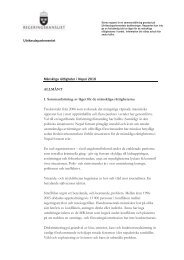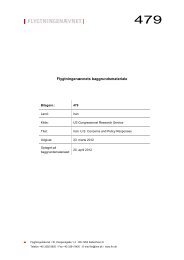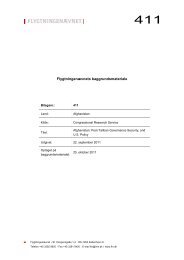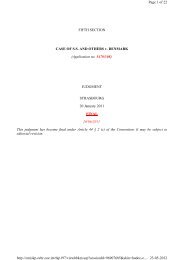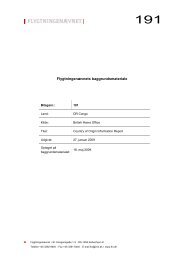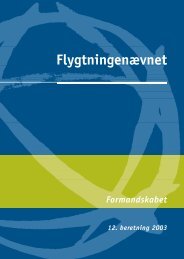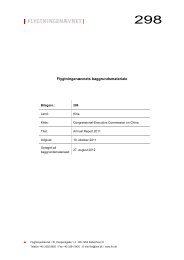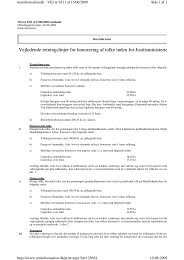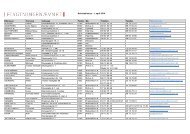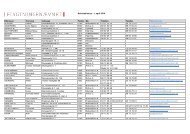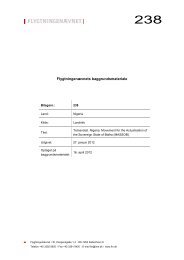Annual Report - National Human Rights Commission
Annual Report - National Human Rights Commission
Annual Report - National Human Rights Commission
Create successful ePaper yourself
Turn your PDF publications into a flip-book with our unique Google optimized e-Paper software.
Annexure 12<br />
○ ○ ○ ○ ○ ○ ○ ○ ○ ○ ○ ○ ○ ○ ○ ○ ○ ○ ○ ○ ○ ○ ○ ○ ○ ○ ○ ○ ○ ○ ○ ○ ○ ○ ○ ○ ○ ○ ○ ○ ○ ○ ○ ○ ○ ○ ○ ○ ○ ○ ○ ○ ○ ○ ○ ○ ○ ○ ○ ○ ○<br />
○<br />
appropriate assignment to institutions. Lugging together indiscriminately all kinds of persons<br />
who are arrested or convicted (or even rescued) into one large warehouse without individuation<br />
or personalised identification or diagnostic distinction is institutional nescience.” (Krishna, V.K.<br />
Iyer, 1988).<br />
Sections 3, 4, 5, 6 and 9 of ITPA<br />
These sections should be made sessions triable with a minimum punishment of five<br />
years (wherever it is not provided for) and the fine amount should be increased to a minimum of<br />
Rs. 25,000.<br />
Section 4<br />
This section dealing with punishment for living on the earnings from prostitution should have a<br />
proviso to ensure the welfare of the children of the person subjected to commercial sexual<br />
exploitation, so that they are not victimised due to the fact that they are looked after by the<br />
mother from her earnings in the brothel.<br />
Section 5<br />
Dealing with trafficking, this section of ITPA should be made more exhaustive, comprehensive<br />
and explicit to bring in all types of trafficking, and all associates, accomplices, financiers,<br />
transporters, facilitators, promoters and all other exploiters within the ambit of the law. Section<br />
5.1 (b) speaks about the intent of the person. This should be replaced with ‘intent or knowledge’,<br />
so that all these exploiters are brought to book.<br />
Section 7 ITPA: Punishment<br />
Under this section two categories of persons are liable: (a) any person who carries on prostitution<br />
and (b) the person with whom such prostitution is carried on. Therefore, part (b) is the section<br />
that becomes applicable to the ‘customers’ or ‘clientele’. A fact that is borne out of the research<br />
is that trafficking cannot be prevented unless deterrent action is taken against those who ‘demand’<br />
the services. Therefore, the punishment to the ‘customers/clientele’ has to be deterrent. Section<br />
7(1A) prescribes a minimum of seven years imprisonment and fine only if the victim is a child,<br />
and in other cases, as per Section 7(1)(b), the punishment for the ‘customer’ is only three months<br />
imprisonment and no fine at all. This needs to be changed. There should be provision for stringent<br />
punishment and a mandatory fine on the ‘customer’. Moreover, the law should state that the<br />
amount taken as fine should go to the victim. However, the study has shown that many teenagers<br />
and children below 18 years are also part of the clientele. They probably venture into brothels<br />
out of curiosity or lack of proper guidance and control. Such persons need to be counselled,<br />
rather than punished. This calls for integrating the provisions of the JJ Act with the ITPA.<br />
Section 7 ITPA: Enlarging the Scope<br />
This section deals with two types of persons, as stated in the previous paragraph. The scope of<br />
the section should be broadened to include a third category of persons, viz., “and any person<br />
<strong>National</strong> <strong>Human</strong> <strong>Rights</strong> <strong>Commission</strong> <strong>Annual</strong> <strong>Report</strong> - 2004-2005<br />
295<br />
AR-Chapter-1-19-10-6-06.p65<br />
315<br />
7/17/06, 6:31 PM



